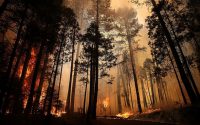The Difficulties of Communicating Risk About the World to the World
By Ryan Wagner, September 22nd, 2019
When writing news stories, especially stories involving the environment, introducing risks to people in your stories is nearly unavoidable. In chapter 3 of Bob Wyss book, Covering the Environment: How Journalists Work the Green Beat (2019), he outlines both the importance of understanding the risk you are reporting on and the ways to properly communicate that risk in your stories properly to a wide variety of people. Risks are often created off the back of scientific data, the problem with this is that people “interpret information, especially scientific findings, in irrational ways” which can be problematic (2019, 37).
When introducing and analyzing risks, journalists must communicate the information and their interpretation in a way that includes not only the “science but psychology, culture, ideology, economics, values and politics” (2019, 42). Essentially, scientifically significant information must be analyzed and expressed in ways that supersede just science, because the risks have impacts throughout human life whether they are direct or indirect. But like mentioned early, this is not an easy task because people often interpret information in irrational ways and due to this many people interpret the same information provided in the same context in different ways. It is up to the journalist to communicate the risk and their own analysis of the risk, and make sure that they distinguish between the two.
In Douglass Fox’s piece, Firestorm, he provides us with detailed insight and analysis of the Pioneer Fire and the risks it created. Often times throughout his story, Fox quotes people referring to the plume of smoke as “like a nuclear bomb” and later compares its heat output to the atomic bomb dropped on Hiroshima in World War II (2018, 99,111). In my opinion, it is very insensitive to compare the two because of the long lasting, irreversible impacts of atomic bombs and nuclear radiation. Although, it does not seem to be Fox’s intention to be insensitive, he was simply attempting to make a comparison to the intense release of energy occurring in the fire. But by comparing the destruction of a forest fire to the destruction caused by an atomic bomb, he ignored their perspective in an attempt to make the issue more relatable to his audience.
Presenting risks to people is not an easy task, it takes practice and a meticulous nature. However, there is no perfect science to doing so because all people experience and interpret life and risks differently from one another. An approach from the Society of Environmental Journalists, on their about page, states that they strive “to advance public understanding of environmental issues.” This is a simple yet effective approach and, in a sense, also the final goal of writing news, to not project personal ideas as fact, but to inform readers about environmental risks and aid their understanding. Finding a balance between facts and factual analysis, while also doing our best to avoid our own bias.
Sources
Wyss, Bob. Covering the Environment: How journalists work the green beat. 2nd Edition, New York: Routledge, 2019. Print.
Kean, Sam. The Best American Science and Nature Writing. New York: Houghton Mifflin Harcourt Publishing Company, 2018. Print.
Society of Environmental Journalists. About SEJ. Online Access: https://www.sej.org/about-sej
